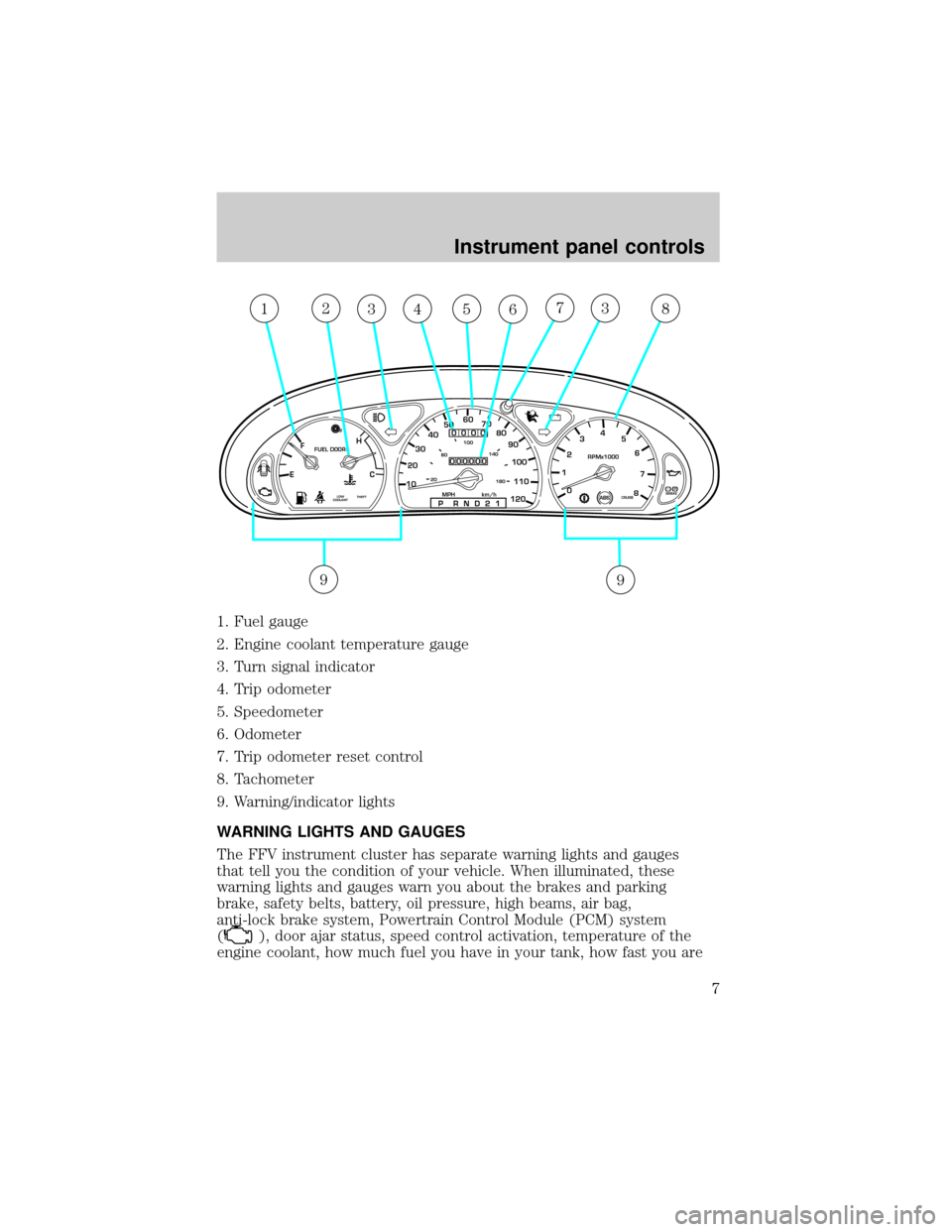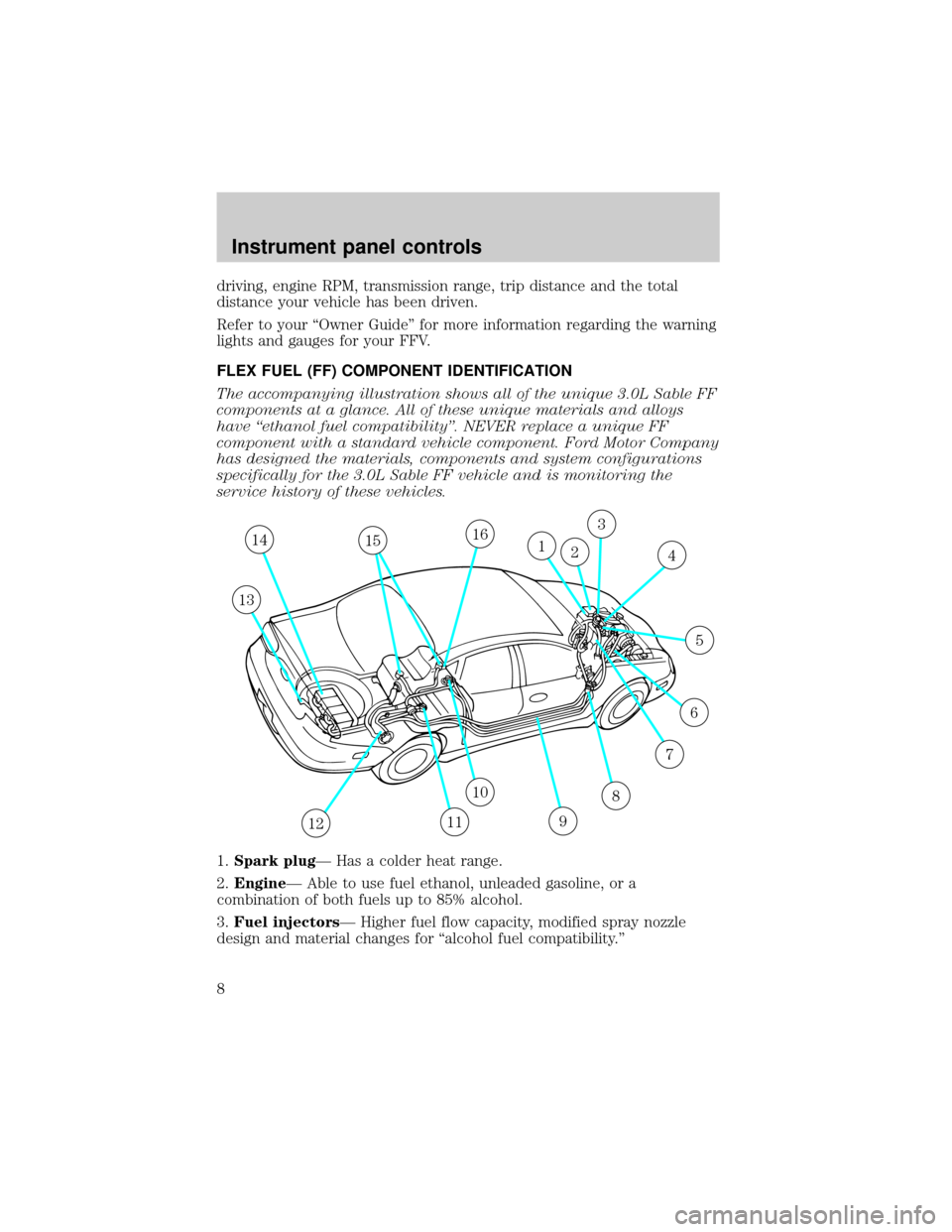engine Mercury Sable 2001 Flex Fuel Vehicle Supplement
[x] Cancel search | Manufacturer: MERCURY, Model Year: 2001, Model line: Sable, Model: Mercury Sable 2001Pages: 16, PDF Size: 0.15 MB
Page 2 of 16

ABOUT THIS SUPPLEMENT
This booklet supplements your ªOwner Guideº and is part of the owner's
portfolio. It describes the operation of your flexible fuel vehicle (FFV)
and how it differs from an unleaded gasoline powered vehicle. Therefore
it is very important that you read this guide and thoroughly familiarize
yourself and others operating the vehicle with this information.
Some of the information in this supplement replaces certain instructions in
the ªOwner Guideº. Please read this supplement carefully and completely.
After reading this supplement, for complete vehicle information, also refer
to the ªOwner Guideº which is included with the vehicle.
VEHICLE IDENTIFICATION
Your vehicle is equipped with a 3.0L flexible fuel (FF) engine and fuel
system. The Sable FFV uses fuel ethanol. Unleaded gasoline may also be
used. However, methanol isnotto be used. A decal on the inside of the
fuel filler door shows you the correct alternative fuel for your FFV. See
theRefuelingsection of this supplement for more information on the
fuels which may be used in your FFV.
Your FFV can be identified by checking the eighth character of the
Vehicle Identification Number (VIN) located on the forward left corner of
your instrument panel. A ª2º indicates the ethanol/gasoline FFV version.
WARNINGS
Warnings remind you to be especially careful in those areas where
carelessness can cause damage to your vehicle or personal injury to
yourself, your passengers or others. Please read all warnings carefully.
ABOUT THE WARRANTIES
The normal vehicle warranties will apply to your flexible fuel vehicle. For
further information, refer to your ªWarranty Information Booklet.º
Specified maintenance procedures must be followed. Repairs must be
made by trained personnel.
It is important that your flexible fuel vehicle be properly maintained by
Ford flexible fuel trained personnel. If a problem occurs, it is important
that properly trained personnel diagnose the cause. If the problem
relates to the fuel system, proper part replacement is imperative to keep
your vehicle operating at normal performance. Flexible fuel components
and standard fuel components are not interchangeable and if your
vehicle is not serviced in accordance with flexible fuel vehicle
procedures, damage may occur and your warranty may be invalidated.
Introduction
2
Page 4 of 16

PREPARING TO START YOUR VEHICLE
Climate conditions and other factors play a large part in deciding how to
start the engine. Read all the starting instructions carefully, so you'll be
aware of these factors when you start the engine.
WARNING: Before turning the key, make sure the parking brake
has been set fully. Place the gearshift in P (Park).
Do not crank the starter continuously for more than 30 seconds at a
time, as starter overheating or other damage could result. If the engine
fails or falters in starting, wait three or four seconds before re-engaging
the starter. If the engine is flooded, or fires intermittently, and fails to
start during a 30±second cranking period, wait two minutes before
attempting to start the engine again.
A computer system controls the engine's idle RPM. When you start your
vehicle, the engine's idling RPM normally runs high. These higher engine
speeds will slow down when the vehicle warms up. If they do not, have
the idle RPM checked.
WARNING: If the engine idling speed does not slow down
automatically, do not allow your vehicle to idle for more than 10
minutes. Have the vehicle checked as soon as possible. Extended
idling at high engine speeds can produce very high temperatures
in the engine, fuel systems and exhaust system, creating the risk
of fire or other damage to the vehicle and possibly resulting in
personal injury.
If fuel odor is detected inside the vehicle, have the vehicle checked by a
qualified service technician.
WARNING: Do not start your vehicle in a closed garage or other
enclosed area. Exhaust fumes can be toxic. Always open the
garage door before you start the engine.
Before you start your vehicle, do the following:
1. Make sure you and all your passengers buckle your safety belts.
2. Make sure your headlamps and other accessories are turned off.
3. Make sure the gearshift lever is in P (Park) and the parking brake is
set before you turn the key.
Starting your vehicle
4
Page 5 of 16

STARTING THE ENGINE
Starting procedure
1. Follow the steps underPreparing to Start Your Vehicle.
2. Turn the key to START until the engine starts, then release the key.
Do not press down on the accelerator.
3. Release the key as soon as the engine starts. Do not hold the key in
START or you could damage the starter. After you start the engine, let it
idle for about 15 seconds.
4. Hold your foot on the brake pedal, put the gearshift lever in gear and
release the parking brake. Slowly release the brake pedal and drive away
in a normal manner.
Cold weather starting
If your flexible fuel vehicle is equipped with an engine block heater, the
standard 110V AC (male) plug is located at the front of the vehicle in
the upper left-hand air inlet opening, under the bumper.
When the temperature is expected to be ±23ÉC (±10ÉF) below and your
vehicle has fuel ethanol (E
d85) in the fuel tank, you should plug in the
engine block heater to ensure a quick start.
If temperatures are expected to remain below ±23ÉC (±10ÉF), it is
recommended that you reduce the alcohol content in your fuel tank to
about 70% by adding unleaded gasoline if your tank is not already full.
Thirteen liters (three gallons) of gasoline will reduce the alcohol in 3/4
full tank from 85% to about 70%. In some areas, winter blends of E
d85
will already contain the extra gasoline. See theRefuelingsection of this
supplement for more information on alcohol fuels.
If you should unexpectedly have 85% alcohol in your fuel tank in
extremely cold temperatures with no way to use the engine block heater,
the engine may require extended crank times and several attempts to
start.
Starting your vehicle
5
Page 6 of 16

If the engine fails to start using the preceding instructions
1. Press the accelerator pedal 1/3 to 1/2 of the way to floor and hold.
2. Turn the key to START position.
3. When the engine starts, release the key, then release the accelerator
pedal gradually as the engine speeds up.
4. If the engine still fails to start, repeat steps one through three.
5. After the engine starts, hold your foot on the brake pedal, put the
gearshift lever in gear and release the parking brake. Slowly release the
brake pedal and drive away in a normal manner.
If your vehicle has alcohol content in the fuel tank between 10% and
30%, and the outside temperature is above 27ÉC (80ÉF), you may
experience a rough or rolling idle after start up. The idle should improve
in 10 to 30 seconds.
Starting your vehicle
6
Page 7 of 16

1. Fuel gauge
2. Engine coolant temperature gauge
3. Turn signal indicator
4. Trip odometer
5. Speedometer
6. Odometer
7. Trip odometer reset control
8. Tachometer
9. Warning/indicator lights
WARNING LIGHTS AND GAUGES
The FFV instrument cluster has separate warning lights and gauges
that tell you the condition of your vehicle. When illuminated, these
warning lights and gauges warn you about the brakes and parking
brake, safety belts, battery, oil pressure, high beams, air bag,
anti-lock brake system, Powertrain Control Module (PCM) system
(
), door ajar status, speed control activation, temperature of the
engine coolant, how much fuel you have in your tank, how fast you are
CRUISE
RPMx1000
0 1234
5
6
7
EFC H
FUEL DOOR>
102030405070 60
80
90
100
110
1202060100
140
180
PMPH km/h
00
000
00000
P!
BRAKEABS
+ –
R N D 2 1THEFTLOW
COOLANT8
123456738
99
Instrument panel controls
7
Page 8 of 16

driving, engine RPM, transmission range, trip distance and the total
distance your vehicle has been driven.
Refer to your ªOwner Guideº for more information regarding the warning
lights and gauges for your FFV.
FLEX FUEL (FF) COMPONENT IDENTIFICATION
The accompanying illustration shows all of the unique 3.0L Sable FF
components at a glance. All of these unique materials and alloys
have ªethanol fuel compatibilityº. NEVER replace a unique FF
component with a standard vehicle component. Ford Motor Company
has designed the materials, components and system configurations
specifically for the 3.0L Sable FF vehicle and is monitoring the
service history of these vehicles.
1.Spark plugÐ Has a colder heat range.
2.EngineÐ Able to use fuel ethanol, unleaded gasoline, or a
combination of both fuels up to 85% alcohol.
3.Fuel injectorsÐ Higher fuel flow capacity, modified spray nozzle
design and material changes for ªalcohol fuel compatibility.º
13
12
3
4
5
8
9
10
1112
151614
6
7
Instrument panel controls
8
Page 9 of 16

4.Fuel railÐ Material changes are made for ªalcohol fuel compatibility.º
5.Engine block heaterÐ If equipped, is used to assist in cold start
below ±23ÉC (±10ÉF).
6.PCM processorÐ Calibration is utilized to optimize engine function
for alcohol fuel operation.
7.Wiring harnessÐ Wiring changes have been made to connect with
the fuel sensor.
8.Fuel sensorÐ Determines the percentage of ethanol in the fuel.
9.Fuel supply lineÐ Material changes are made for ªalcohol fuel
compatibility.º
10.Fuel pump assembly/fuel sending unitÐ Fuel pump specifically
designed for alcohol fuels. Stainless steel parts are used.
11.Vapor control valveÐ Controls vapor flow to charcoal canister.
12.Filler tubeÐ Improved coating is applied and anti-siphon screens
installed.
13.Charcoal canister trayÐ Protective enclosure.
14.Evaporative emission systemÐ Charcoal canister system enlarged
and modified for additional alcohol fuel vapor capacity and higher vapor
flow.
15.Vapor (roll over) valvesÐ Helps to increase fuel capacity and
vapor flow. Material changes are made for ªalcohol fuel compatibility.º
16.Fuel tankÐ A 68.2 liter (18 gallon) specially coated steel fuel tank
is used for ªalcohol fuel compatibility.º
ªAlcohol fuel compatibilityº means that the component performs
satisfactorily, is durable and does not contaminate the fuel when tested
in worst-case ethanol-gasoline blends up to 85% alcohol.
Instrument panel controls
9
Page 10 of 16

REFUELING
Use only fuels which meet the type specified for the calibration number
printed on the calibration decal. Use of other fuels may cause powertrain
damage as well as loss of vehicle performance. It will also invalidate the
Ford Warranty and any extended service agreement.
WHAT FUELS SHOULD BE USED?
Your Sable FFV uses fuel ethanol. Unleaded gasoline may be also used.
However,do notuse fuel methanol. The correct fuel for your FFV is
shown on a decal, located on the inside surface of the fuel filler door.
These vehicles will operate well on ordinary commercial quality unleaded
regular gasoline, but only the highest quality fuel ethanol will provide the
same level protection and performance.
Standards for these fuels have been developed to provide FFVs the best
possible performance, safety and durability. To assist alcohol fuel
providers in meeting these standards, guidelines have also been
developed which prescribe ªEthanol Fuel Compatibleº dispensing station
equipment. Fuel stations may apply to be certified as meeting these
standards. However, not all stations meet these standards at this time. To
ensure proper operation of your Sable FFV on fuel ethanol, refuel at
certified stations. These standards and guidelines can be obtained from
the Ford Motor Company Alternative Fuels Program (call toll-free
1-800-ALT-FUEL (258-3835) or contact the U.S Dept of Energy
Altertnative Fuels Data Center (call toll±free 1-800-423-1DOE
(423-1363).
WHAT IS FUEL ETHANOL (E
D85)?
Pure ethanol is the alcohol which is the intoxicating agent in liquor, beer
and wine. It is distilled from the fermentation of plants such as field corn
and sugar cane. When ethanol is used in the making of motor fuels, a
small amount of a bad tasting chemical is added to discourage beverage
use. The resulting fuel is called E
d100 meaning 100% pure ethanol
diluted by 2% to 5% gasoline as the ªdenaturant.º
Fuel ethanol (E
d85) is then made by adding 15% more unleaded
gasoline. The resulting fuel also has a higher octane rating than unleaded
regular gasoline and other properties which allow engine designs with
greater efficiency and power.
Servicing your vehicle
10
Page 11 of 16

Winter blends may contain up to 30% unleaded gasoline (25% plus the
denaturant) to enhance cold engine starts. Severely cold weather may
require additional measures for reliable starting. This supplement
contains specific information for starting under these conditions.
Ethanol is more chemically active than gasoline. It corrodes some metals
and causes some plastic and rubber components to swell, break down or
become brittle and crack, especially when mixed with gasoline. Special
materials and procedures have been developed for the Sable FFV and for
the dispensers used by ethanol fuel providers.
Ethanol also has less energy per liter (gallon), so fuel economy in
kilometer per liters (miles per gallon) will decrease as the percentage of
ethanol goes up.
U.S. government regulations require fuel ethanol dispensing pumps
to have a small, square, orange and black label with the common
abbreviation for the fuel such as: ªE85º above the mid-line and the
words ªMINIMUM xx% ETHANOLº below the mid-line. The ªxx%º is
replaced with either ª70%º or ª85%º as appropriate for the region.
SeePrecautionary Informationfor more fuel information.
Use of other fuels may cause powertrain damage as well as loss of
vehicle performance. It will also invalidate your extended service
agreement.
Do not operate the engine while refueling. Do not smoke while refueling.
WARNING: Do not modify the fuel system configuration or
components, or replace components with parts not especially
designed for use with fuel ethanol. Ford Motor Company has
specially designed the materials, components and system
configuration for ethanol-fueled vehicles and the particular
system is precisely calibrated for efficient operation. The use of
different parts or materials could produce an untested
configuration that could result in fire, personal injury, or could
cause engine damage.
ADDING ENGINE OIL
Ethanol/gasoline flexible fuel vehicles use Motorcraft engine oil (part
number XO-5W30-QSP or XO-10W30-QSP, meeting Ford specification
WSS-M2C153-G) designed for gasoline fueled vehicles.
Servicing your vehicle
11
Page 12 of 16

Use of a specific oil is mandatory for proper operation of flexible fueled
engines throughout the warranty period and for validation of the
extended service agreement.
Oil change intervals must be maintained at the recommended intervals.
Refer to the ªService Guideº for the service interval schedules.
SPARK PLUGS
The spark plugs used in the flexible fuel vehicle are different than those
used in the gasoline-powered vehicle. This is necessary to prevent engine
damage due to pre-ignition.
Standard spark plugs must never be installed on the FFV engine,
because disabling and expensive engine damage may occur. Proper spark
plugs may be purchased through your dealer.
The FFV vehicle recommended Motorcraft spark plugs part number
AGSF-22PP, which is installed as original equipment,mustalways be
used foralltypes of fuels.
LONG-TERM STORAGE
Due to the small amounts of corrosive impurities that may be found in
E
d85, it is recommended that the fuel be switched over to 100%
high-quality unleaded gasoline prior to long-term storage of your FFV.
Servicing your vehicle
12